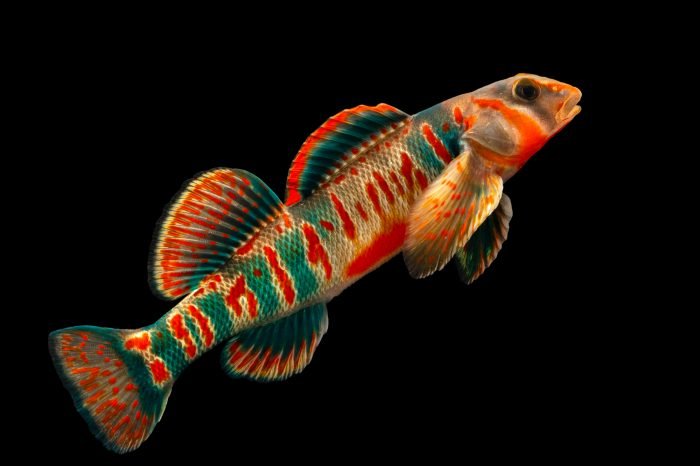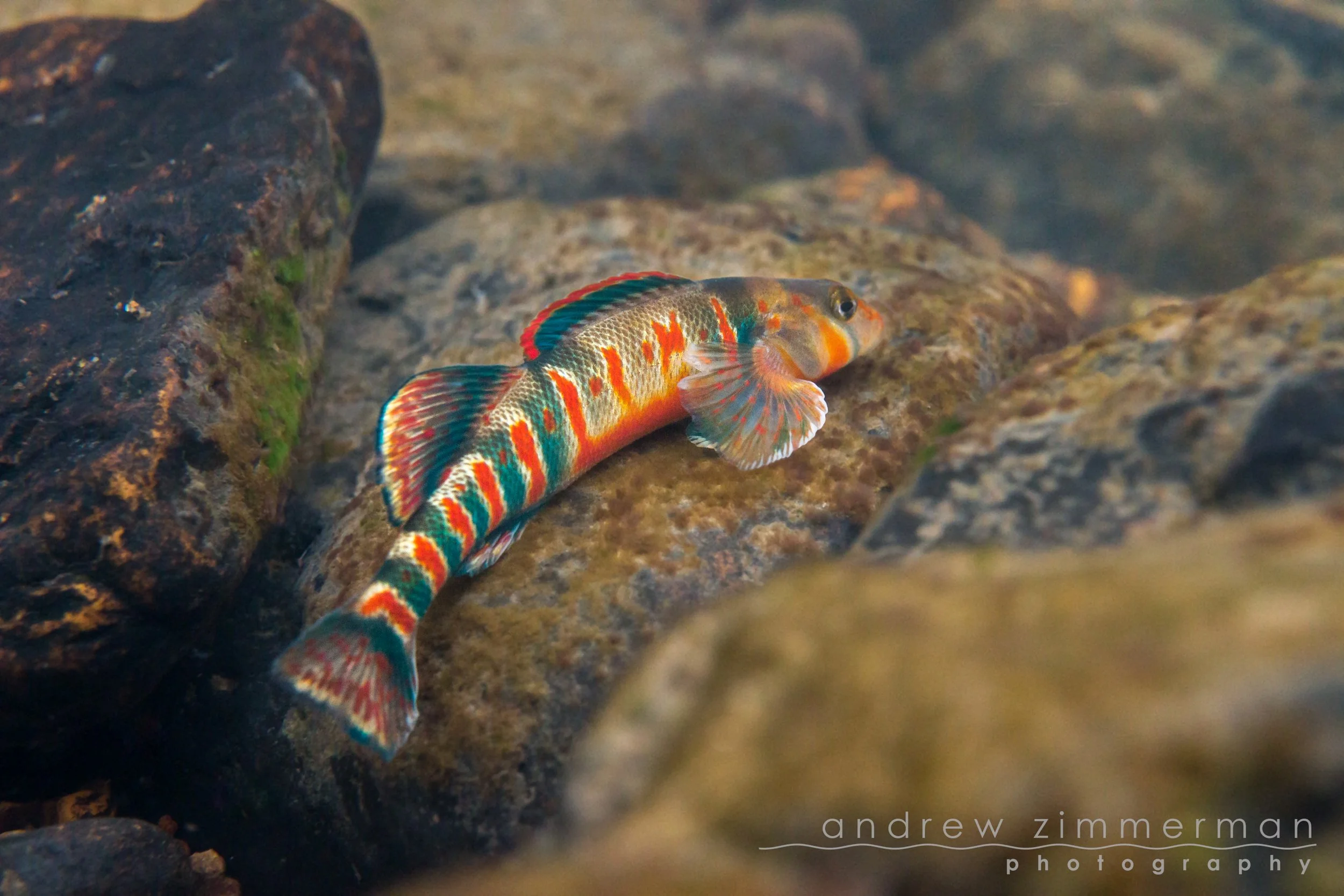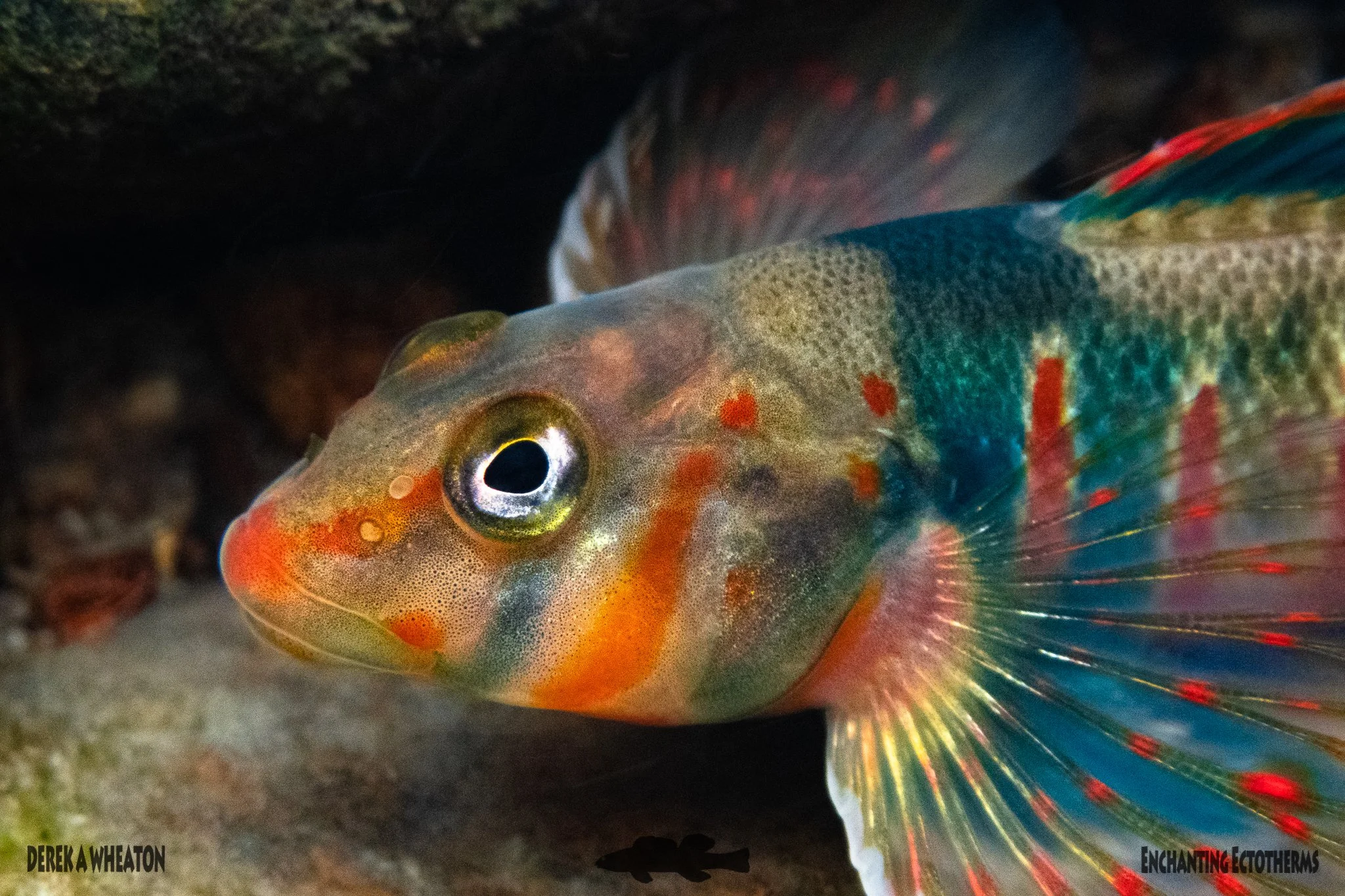Image by Joel Sartore
Candy Darter | Etheostoma osburni
Status: IUCN: Near Threatened (2011); USFWS Endangered (2018)
CFI Status: Propagated from 2025-Present for propagation protocols and introduction. (What do these terms mean?)
-
The Candy Darter is a true showstopper—its vibrant, bold colors have an undeniable wow factor that captivates anyone who sees it. This little fish isn’t just beautiful for a freshwater species; its striking hues could rival even the most colorful creatures of the saltwater world! Its vibrance has a way of engaging the public, drawing attention to the importance of conserving non-game species.
With its brilliant teal, red, and orange colors, the Candy Darter is a true gem of the Appalachian waterways. It is found in the Gauley, Greenbrier, and New River watersheds, thriving in clear, rocky streams with swift currents. These tiny fish live up to five years and start breeding at two, laying their eggs in fine gravel riffles during spring.
Sadly, this species has faced a tough history. Nearly half of its known populations have disappeared since the species was first described in 1932, and in 2018 the Candy Darter was officially listed as Endangered under the Endangered Species Act by the U.S. Fish and Wildlife Service. Threats to this species include sedimentation and increased water temperatures due to deforestation, and stream acidification from mining practices.
-
The Candy Darter’s home in the Appalachian region faces many environmental threats, including deforestation, mining, and poor agricultural practices. However, one of its biggest challenges comes from its larger sister species, the Variegate Darter. These two species compete for the same resources—space, food, and, most importantly, mates.
In many cases, when different species hybridize, their offspring are sterile. Unfortunately, this isn’t true for the Candy Darter. When it interbreeds with the Variegate Darter, their offspring remain fertile, allowing multiple generations of hybrids to form. Over time, this genetic swamping dilutes the Candy Darter’s unique traits, eventually erasing it from the wild.
Hybridization wasn’t always an issue. Natural barriers like Kanawha Falls once kept Variegate Darters downstream, preventing them from intermingling with Candy Darters. However, in the late 20th century, Variegate Darters were introduced upstream, likely through live bait use in fishing. Today, hybridization is a major concern across much of the Candy Darter’s range. Thankfully, large dams are helping protect populations in the Upper Gauley and Middle New River watersheds.
One way to help the Candy Darter thrive is by establishing populations in streams free from the Variegate Darter. With dedicated care and conservation efforts, there’s hope that this species will continue to grace Appalachian streams for generations to come.
-
CFI hopes to lend a helping hand in the restoration and security of the Candy Darter. In partnership with the Virginia Department of Wildlife Resources and the U.S. Fish and Wildlife Service’s Abingdon, VA office, we’re working together to give the Candy Darter a fighting chance. Our goal is to refine propagation techniques, learn more about its life history, and restore this species throughout its range. By releasing young Candy Darters into protected streams, we hope to secure a future for this impressive species.
Kanawha River Basin in West Virginia and Virginia.
Native Range
Threats
Habitat fragmentation, mining, sedimentation, deforestation, and hybridization. What do these terms mean?
Spawning Habitat Preferences: Substrate spawners in pebble and gravel substrate between larger cobbles and boulders.
Relevant Literature: Dunn, C.G. 2013. Comparison of habitat suitability among sites supporting strong, localized, and extirpated populations of Candy Darter Etheostoma osburni. Final Report to the Virginia Department of Game and Inland Fisheries, Richmond, VA.
George, A.L., Kuhajda, B.D., Williams, J.D. Cantrell, M.A., Rakes, P.L., and Shute, J.R. 2009. Guidelines for Propagation and Translocation for Freshwater Fish Conservation. Fisheries 34:529-545.
McBaine, K. and E. Hallerman. 2020. Demographic status and population genetic differentiation of Candy Darter populations in Virginia. Final Report to the Virginia Department of Wildlife Resources. Henrico, VA. 95 pp.
U.S. Fish and Wildlife Service. 2018. Candy Darter recovery outline. West Virginia Ecological Services Field Office, Elkins, WV. 11 pp.
Virginia Department of Game and Inland Fisheries. 2015. Virginia’s 2015 Wildlife Action Plan. Henrico, VA. 1135 pp.
Isaac Gibson, Amy B. Welsh, Stuart A. Welsh, Daniel A. Cincotta. 2019. Genetic swamping and species collapse: Tracking introgression between the native Candy Darter and introduced Variegate Darter. Conservation Genetics
In Partnership With: Virginia Department of Wildlife Resources (VDWR) & USFWS (Abingdon, VA)
Photo by Andrew Zimmerman.
Photo by Derek Wheaton.
Photo by Derek Wheaton.









